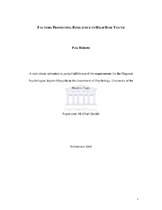| dc.description.abstract | The following study aimed to explore the development of resilience within male youth, despite exposure to numerous factors traditionally classified as high-risk. The research focussed on the developmental process of six male youth who engaged in positive coping through actively seeking protection in a high-risk environment, in the form of a non government organization within their community. The study assumed that the active seeking of a protective environment by high-risk youth is an indication of resilience. A phenomenological approach was used to understand the processes that aided the development of resilience within the individuals, through semi-structured in-depth interview guides. Qualitative thematic analysis was utilized to attain and understand common themes. An ecosystemic approach was used in conceptualizing the findings of this research. Indications of resilient development within male youths, relating to systemic
factors, which contributed to resilience were explored. The major findings of this research were congruent with past research, both in South Africa and internationally. Three primary themes of support, control, and security emerged from the analysis. The research findings indicated that individuals possessing an internal locus of control were able to cope with adversity and had hence developed resilience. The participants in this sample were confident in their abilities, possessed
motivation and belief in success. Systemic factors that were elicited as important in the optimal development of resilience were belief in the youth’s ability, and faith in their capacity to achieve,as well as providing support and guidance to youth when needed. The research found that if youth were faced with factors understood as high-risk, and were able to overcome them, these risk factors served to further enhance resilience. This research offers researchers and community organizations further insight into effective intervention programs to promote optimal youth
development in high-risk areas. | en_US |

